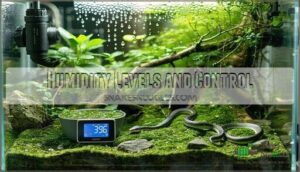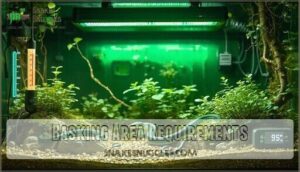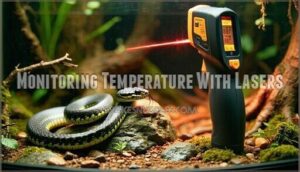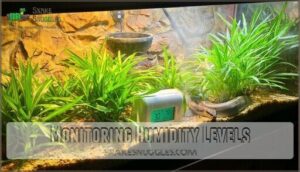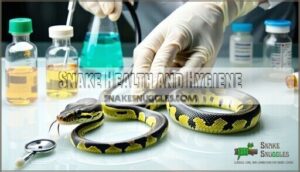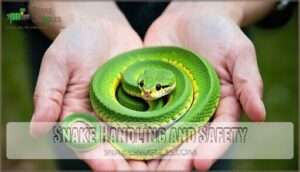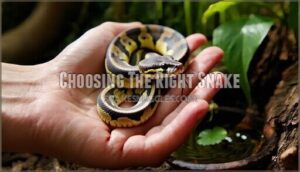This site is supported by our readers. We may earn a commission, at no cost to you, if you purchase through links.
 You’ll master snake health and husbandry practices by setting up a secure, spacious enclosure with proper temperature gradients—think basking zones at 88-92°F and cool spots around 75°F.
You’ll master snake health and husbandry practices by setting up a secure, spacious enclosure with proper temperature gradients—think basking zones at 88-92°F and cool spots around 75°F.
Keep humidity between 60-75% to avoid shedding woes and respiratory drama.
Feed frozen-thawed prey matched to your snake’s girth, and change water every few days.
Spot-clean messes, deep-clean monthly, and schedule annual vet visits for peace of mind.
Handle your snake gently and watch for stress signals; nobody likes a jumpy roommate.
With these basics, you’ll keep your snake slithering in style—stay tuned for pro tips that turn good care into great results.
Table Of Contents
- Snake Habitat Requirements
- Humidity and Hydration
- Snake Diet and Nutrition
- Snake Health and Hygiene
- Snake Handling and Safety
- Snake Behavior and Enrichment
- Snake Life Cycle and Growth
- Snake Care and Maintenance
- Choosing The Right Snake
- Frequently Asked Questions (FAQs)
- What is husbandry in snakes?
- How to keep snakes healthy?
- What is the proper husbandry for a ball python?
- Do vets have to treat snakes?
- What is husbandry for snakes?
- What husbandry needs for snakes?
- What are the requirements for reptile husbandry?
- Are snakes happy in captivity?
- What are common signs of stress in snakes?
- How can I tell if my snake is dehydrated?
- Conclusion
Snake Habitat Requirements
Creating a proper habitat forms the foundation of successful snake ownership, directly impacting your pet’s health, behavior, and lifespan.
You’ll need to carefully balance several environmental factors including enclosure size, temperature gradients, humidity levels, and enrichment features to replicate your snake’s natural living conditions.
Aquarium Size and Type
Your snake’s new home needs careful planning.
Choose a glass aquarium or PVC enclosure that’s at least as long as your snake and half as wide.
Make certain escape-proof latches and proper ventilation to prevent humidity buildup.
Glass offers better visibility, while PVC retains heat efficiently.
Species-specific requirements vary, so research your snake’s adult size before purchasing.
Substrate Options
Choosing the right foundation for your snake enclosure setup determines your pet’s comfort and your maintenance workload.
Smart substrate options prevent impaction risk while supporting natural behaviors.
Here are four proven snake substrate choices for ideal enclosure materials:
- Paper towels – Absorbent, hygienic, perfect for quarantine and hospital setups
- Reptile mats – Washable, reusable, ideal for juvenile snakes requiring easy cleaning
- Newspaper – Cost-effective, highly absorbent, excellent for monitoring waste and health
- Aspen bedding – Natural burrowing substrate, great odor control, supports species-specific behaviors
The selection between these depends on reptile substrate needs.
Temperature and Lighting Needs
Your snake’s thermal health depends on proper temperature gradients and reptile lighting. Create basking spots at 88-92°F using basking bulbs, while maintaining cool zones at 75-80°F.
Night temperatures can drop to 75°F safely. Install UV lighting on 12-hour light cycles to support natural rhythms.
For ideal health, aim for a humidity range of 60-75%. Use thermostats for precise temperature control and consider seasonal adjustments to mimic natural habitat changes throughout the year.
Humidity Levels and Control
Proper humidity control can make or break your snake’s health.
Digital hygrometers placed near substrate give accurate readings for species-specific needs. Many owners find success with a snake digital hygrometer.
- Monitor humidity levels using calibrated digital hygrometers for precise measurements
- Create humidity boxes with moistened sphagnum moss to prevent shedding problems
- Adjust misting techniques based on species variation – ball pythons need 60-80%, corn snakes require 40-50%
Hiding Places and Decorations
Beyond humidity control lies another essential aspect of snake care. Your reptile’s mental health depends heavily on strategic hiding places and environmental enrichment. Think of your snake enclosure furniture as both functional necessities and stress-relief tools.
Every snake needs multiple hiding spots – one on the warm side, another on the cool side. A proper snake hide box should fit snugly around your pet without being cramped.
Climbing structures like sanitized branches offer enrichment benefits while satisfying natural behaviors. Decoration safety trumps snake aesthetics every time.
Avoid sharp edges, toxic materials, and anything your snake might swallow. Hiding variety keeps things interesting – try half-logs, cave-like structures, or even PVC pipes for burrowing substrates enthusiasts.
Daytime and Nighttime Temperature Ranges
During thermal cycling, your snake’s body temperature naturally fluctuates with day/night patterns.
Maintain daytime temperatures at 85-95°F on the warm end, dropping to 75-80°F at night.
Species variation affects these ranges—colubrids prefer cooler temps while pythons need higher heat.
Thermostat control prevents dangerous overheating and guarantees consistent nighttime drops that promote healthy basking behavior and peak snake health.
Basking Area Requirements
Creating an effective basking area keeps your snake healthy and comfortable. Your pet needs proper heat sources and temperature management for ideal thermoregulation.
Here’s what you’ll need:
- Lamp Distance – Position heat lamps 6-12 inches above the basking spot to prevent overheating
- Temperature Gradient – Maintain 85-95°F basking temperatures with cooler areas at 75-80°F
- Bulb Wattage – Use appropriate wattage (25-150W) based on enclosure size and species requirements
- Rock Material – Choose flat stones or ceramic tiles that retain heat without sharp edges
Timer Settings help maintain consistent day/night cycles. Monitor your snake’s basking behavior – they’ll move between warm and cool zones naturally when temperature requirements are met properly.
Avoiding Thermal Burns
Most snake keepers underestimate how easily thermal burns develop from improper heat sources.
Never use heating rocks or ceramic heat emitters without Thermostat Use – they create dangerous hot spots.
Position overhead Bulb Wattage appropriately, maintaining Safe Distances of 6-12 inches from basking surfaces.
Heater Placement should create gradual temperature gradients, not scorching zones.
If Burn Treatment becomes necessary, consult an exotic veterinarian immediately, as these injuries often lead to serious snake health issues requiring professional intervention.
Monitoring Temperature With Lasers
Three key tools make laser thermometers your best friend for snake health monitoring.
These infrared devices provide accurate readings of basking spots and thermal gradients without disturbing your snake.
Proper laser monitoring prevents thermal burns while ensuring ideal snake temperature regulation across different species’ unique requirements.
- Point-and-shoot accuracy – Laser thermometers give instant temperature readings from multiple enclosure zones without opening the habitat
- Safe distance monitoring – Check hot spots and thermal gradients without risking burns to yourself or stressing your snake
- Species-specific tracking – Different snakes need different temps; lasers help you dial in exact requirements for your particular species
- Heat map creation – Regular laser readings help you identify cool spots, hot zones, and perfect thermal gradients throughout the enclosure
Importance of Day/Night Cycle
Your snake’s circadian rhythm depends on proper day-night cycle lighting.
Install timers for 12-hour light cycles to trigger natural melatonin production and behavioral changes.
This impacts breeding success and prevents health implications like stress-related illness.
Consistent snake lighting supports snake health and husbandry by maintaining temperature requirements and humidity needs naturally, which is crucial for overall husbandry.
Humidity and Hydration
Proper humidity and hydration form the foundation of snake health, directly affecting everything from successful shedding to respiratory function.
You’ll need to maintain precise moisture levels while providing constant access to fresh water to keep your serpentine companion thriving, with hydration being crucial for overall health.
Ideal Humidity Levels for Snakes
Your snake’s humidity sweet spot sits between 50-60%, though species variation means some pythons prefer higher levels while others thrive lower.
Getting this balance right prevents shedding problems and supports respiratory health through proper snake enclosure environment management. Digital hygrometers guarantee accurate humidity readings.
- Use hygrometer calibration monthly to guarantee accurate readings throughout your snake’s habitat
- Create a humidity gradient with drier cool zones and moister warm areas for natural behavior
- Monitor snake humidity needs closely during shed cycles when reptile hydration becomes critical
- Maintain consistent humidity management as part of thorough snake health and husbandry practices
Consequences of High and Low Humidity
Humidity imbalances spell trouble for your serpent friend.
Excessive moisture creates perfect breeding grounds for bacterial growth and triggers respiratory infections that’ll have your snake wheezing.
Meanwhile, inadequate humidity causes shedding problems and dehydration risks, leaving your pet with stuck skin patches.
Consider humidity boxes for targeted snake humidity control.
Regular Soaking and Bowel Movements
Weekly soaking sessions help your snake’s digestive system work like clockwork.
A 10-15 minute warm water bath once per week often triggers bowel movements, preventing impaction prevention issues.
Keep water shallow and clean for safe soaking benefits.
This simple snake care tip supports healthy digestion and reptile health maintenance routines.
Providing a Water Source
Always make certain your snake has access to clean, fresh water in an appropriately sized water bowl.
The water dish placement should allow easy access while maintaining proper hydration methods.
Species water needs vary, but most snakes require containers large enough for soaking.
Change water every 2-3 days to maintain snake water quality and prevent bacterial growth that compromises water source hygiene.
Monitoring Humidity Levels
Proper hygrometer placement guarantees accurate readings in your snake’s world. Digital hygrometers outperform analog versions, providing precise humidity expert control for ideal snake health management. Strategic positioning away from water bowls prevents false readings.
- Position hygrometers mid-level in the enclosure for accurate reptile humidity management readings
- Adjust misting frequency based on species needs and seasonal shedding problems prevention
- Install humidity boxes with moistened substrate for localized microclimate control in snake enclosures
Snake Diet and Nutrition
Getting your snake’s diet right isn’t rocket science, but it’s absolutely critical for their health and longevity.
You’ll need to understand their carnivorous requirements, proper prey selection, and feeding schedules to keep your scaly friend thriving, which involves grasping complete concepts.
Carnivorous Diet and Meat Requirements
Your snake’s carnivorous diet isn’t negotiable—they’re obligate meat-eaters requiring whole prey that matches their natural feeding patterns.
Snakes are nature’s perfect predators—whole prey feeds their wild instincts even in captivity
Understanding their nutritional needs prevents costly health issues:
- Prey size should match your snake’s thickest body section
- Feeding frequency varies by age—juveniles need weekly meals, adults biweekly
- Avoiding overfeeding prevents obesity and regurgitation problems
Proper snake nutrition means respecting their wild instincts while maintaining captive safety.
Feeding Frozen-Thawed Prey
Frozen-thawed prey offers superior safety and nutritional retention compared to live feeding.
You’ll eliminate injury risks while maintaining your snake’s carnivorous diet requirements.
Follow these proven thawing methods:
- Warm Water Bath: Submerge sealed prey in 100-110°F water for 30-60 minutes
- Room Temperature: Allow 4-6 hours for complete thawing before feeding
- Prey Size Matching: Select items matching your snake’s widest body diameter
This approach prevents refusal causes while ensuring safe handling and ideal snake nutrition.
Avoiding Live Prey and Disease Transmission
Live prey poses serious risks you can avoid entirely.
Frozen-thawed prey eliminates prey trauma risk and parasite introduction while maintaining frozen prey nutrition.
Rodents carry diseases, parasites, and bacteria that threaten your snake’s health.
| Risk Factor | Live Prey | Frozen-Thawed |
|---|---|---|
| Parasite Introduction | High risk of internal parasites | Eliminated through freezing process |
| Bacterial Contamination | Salmonella, E. coli transmission | Reduced bacterial load |
| Prey Trauma Risk | Bites, scratches, stress injuries | Zero physical harm to snake |
| Nutritional Value | Variable, depends on rodent health | Consistent, preserved nutrition |
| Ethical Considerations | Rodent suffers during predation | Humane pre-killing method |
Pre-killed options support snake disease prevention and snake parasite control while simplifying your feeding routine.
Your snake veterinary care costs drop when you choose frozen-thawed prey over risky live alternatives.
Feeding Frequency and Portion Control
Balanced feeding schedules prevent obesity prevention challenges while supporting healthy growth.
Juvenile feeding requires meals every 5-7 days, while adults eat every 7-14 days.
Match prey size to your snake’s widest body diameter—think "swallowing a golf ball, not a basketball."
Monitor portions carefully; adult portions should create a slight bulge after eating.
Proper nutrition timing supports ideal reptile diets and snake dietary needs.
Nutritional Supplements and Vitamins
Most snakes eating whole rodents don’t need routine nutritional supplements since prey provides complete nutrition.
However, species consuming fish, eggs, or non-mammalian prey may require calcium supplementation to prevent metabolic bone disease.
Vitamin D3 paired with calcium helps snakes without UVB exposure, and it’s crucial to watch for deficiency signs like stunted growth or bone deformities.
Avoid over-supplementation which can cause organ damage, and consult your reptile veterinarian before starting any supplement regimen.
Snake Health and Hygiene
Keeping your snake healthy requires vigilance and proper husbandry practices that prevent common diseases before they become serious problems.
You’ll need to recognize early warning signs of illness, maintain strict hygiene protocols, and establish a relationship with a reptile-experienced veterinarian to guarantee your pet thrives for years to come.
Common Health Issues in Snakes
After sorting out diet, keep an eye out for common health issues like Respiratory Infections, Mouth Rot, and Retained Sheds.
Parasite Prevention is key—mites and worms love a messy tank. Metabolic Disease can sneak up if nutrition’s off.
Regular snake veterinary treatment helps catch reptile diseases early, so don’t wait for your snake to start wheezing or shedding oddly, and remember Parasite Prevention.
Recognizing Signs of Illness
Your snake’s behavior tells a story—watch for lethargy signs and appetite changes that signal trouble brewing.
Early detection of snake diseases prevents costly vet visits and keeps your pet healthy.
Key warning signs include:
- Respiratory distress – wheezing, mouth breathing, or mucus discharge
- Shedding issues – retained skin patches or incomplete molting cycles
- Abnormal swelling – lumps, bumps, or distorted body shape
Monitor eating habits closely since appetite changes often precede other snake health issues.
Common health problems like infectious stomatitis show obvious symptoms, while disease diagnosis requires recognizing subtle behavioral shifts alongside physical snake disease symptoms.
Quarantine and Isolation Procedures
Your new reptile’s arrival brings excitement, but implementing proper quarantine procedures protects your entire collection.
Establish a separate isolation setup for fourteen days minimum, monitoring symptoms daily while maintaining strict biosecurity protocols.
This quarantine length prevents disease prevention nightmares and reduces stress reduction for existing snakes.
Think of it as your reptile’s mandatory vacation before joining the family.
Cleaning and Disinfecting The Aquarium
Maintaining proper cleaning routines keeps your snake’s environment healthy and prevents disease buildup.
Regular waste removal and water quality checks form the backbone of effective biosecurity in any snake enclosure. Remember to take into account how terrarium size impacts health.
Essential cleaning steps include:
- Spot-clean immediately – Remove feces, shed skin, and uneaten food within 24 hours
- Weekly water changes – Replace all water and scrub bowls with safe disinfectants
- Monthly deep clean – Empty enclosure, wash all surfaces, and check for algae control needs
- Substrate replacement – Change bedding based on soiling, typically every 2-4 weeks
Regular Veterinary Check-Ups
Establishing a partnership with your reptile veterinarian transforms snake ownership from guesswork into confident care. Annual vet visits provide preventative care and early detection of health issues before they become serious problems.
| Visit Component | Frequency | Purpose |
|---|---|---|
| Physical Examination | Annually | Overall health assessment |
| Fecal Screening | Every 6 months | Parasite prevention |
| Blood Work | As needed | Internal health monitoring |
| Husbandry Review | Each visit | Environmental optimization |
| Emergency Consultation | When needed | Immediate health concerns |
Specialist vets trained in reptile veterinary medicine understand snake physiology and can spot subtle signs that general practitioners might miss. Your veterinary care routine should include baseline health records and regular parasite screening. These proactive vet visits catch problems early, reducing treatment costs and improving outcomes for your snake’s long-term health. Establishing a consistent care routine with a reptile veterinarian is key to providing the best possible life for your snake, through preventative care and early detection of potential issues, leading to a better quality of life.
Snake Handling and Safety
Proper snake handling protects both you and your reptile from injury while reducing stress for your pet.
You’ll need to master specific techniques that support the snake’s body weight and respect its natural behavior patterns to guarantee safe, comfortable interactions, which is crucial for safe handling.
Safe Handling Techniques
Proper snake handling requires patience and technique. Think of yourself as a snake whisperer—your calm energy translates directly to your pet.
Support their entire body weight to prevent injury and stress.
- Use both hands: One supports the head/neck area, the other cradles the mid-body
- Move slowly: Quick movements trigger defensive responses and handling stress
- Stay confident: Hesitant movements confuse snakes and increase bite risk
Gentle handling builds trust over time, making future interactions smoother for both of you.
Avoiding Bites and Scratches
Reading your snake’s temperament prevents most bites—watch for defensive posturing or rapid movements before handling.
You’ll avoid scratches by moving slowly and confidently; sudden jerks trigger defensive responses.
Safe handling means never grabbing from above—snakes perceive this as predatory.
Supervise children closely during interactions, teaching them proper handling techniques that respect the animal’s natural behavior patterns.
Supporting The Snake’s Body
Your snake’s body weight needs even support across multiple contact points to prevent injury.
Use gentle handling techniques with a secure grip under the snake’s midsection and rear third. This distributes pressure evenly, reducing stress on snake anatomy while maintaining control.
Understanding snake health and wellness through proper snake husbandry guidelines protects against snake common diseases during handling sessions.
Handling Frequency and Duration
How often should you handle your snake? Less is more in snake handling—limit sessions to brief interactions every few days to prevent handling stress and maintain your pet’s well-being.
Here are three key guidelines for ideal handling frequency:
- Juvenile snakes: Handle 1-2 times weekly for 5-10 minutes maximum
- Adult snakes: Handle every 3-5 days for up to 15 minutes
- Post-feeding: Wait 48-72 hours before any handling to prevent regurgitation
Watch for stress signs like defensive posturing or rapid breathing. Your snake’s temperament and owner experience level should guide session length. Calm handling with gentle movements reduces bite prevention needs while ensuring safe support throughout each interaction.
Supervising Children and Pets
Two critical factors determine safe snake interactions: child safety and enclosure security.
Never leave children unsupervised with snakes, as even docile species can bite unexpectedly.
Proper snake handling requires adult guidance to prevent snake stress and guarantee everyone’s wellbeing.
- Always maintain direct adult supervision during all snake interactions
- Teach proper hygiene practices – handwashing before and after handling prevents disease transmission
- Secure enclosure locks prevent unauthorized access and potential bite prevention incidents
- Keep other pets separated during snake handling to avoid territorial conflicts and stress
Snake Behavior and Enrichment
Understanding your snake’s natural behaviors helps you create an environment that promotes both physical health and mental well-being.
You’ll need to provide enrichment opportunities that encourage species-appropriate activities like climbing, hiding, and exploring to prevent stress-related health issues.
Understanding Snake Behavior
Observing your snake reveals fascinating Individual Personalities and Communication Signals.
Watch for Defensive Postures like coiling or hissing when stressed. Unlike mammals, snakes have minimal Social Interactions—they’re solitary creatures.
Monitor Activity Patterns: nocturnal species become active at dusk. Each snake displays unique behaviors, from curious exploration to defensive retreats.
Understanding these signals helps you provide better snake care and maintain ideal snake enclosure environment control for wellness.
Providing Environmental Enrichment
Enrichment transforms your snake’s basic habitat into a dynamic environment that promotes natural behaviors and cognitive health.
Research shows enriched environments can increase brain volume by up to 3.2% while reducing stress behaviors.
Essential snake enrichment includes:
- Climbing Structures – branches and cork rounds for vertical exploration
- Burrowing Opportunities – dig boxes with safe substrates like dried rice
- Sensory Stimulation – rotating novel objects and organic materials like moss
Puzzle feeders encourage foraging behavior, while varied hiding spots support natural exploration patterns.
Creating a Stimulating Environment
Your snake’s habitat becomes their personal playground through strategic enrichment activities. Install climbing structures like sturdy branches and cork bark tubes that mirror their natural environment.
Add puzzle feeders to challenge their hunting instincts and provide sensory stimulation. Rotate decorations weekly to maintain novelty.
Multiple hiding spots at different temperatures create comfort zones, while varied textures encourage exploration and natural behaviors.
Encouraging Natural Behavior
Why settle for a boring terrarium when you can create an adventure playground?
Design hunting simulations using feeding puzzles and hidden prey items. Add climbing structures like branches and rocks for arboreal species.
Create burrowing opportunities with deeper substrate layers. Include sensory enrichment through varied textures and scents.
These enrichment activities mirror natural snake behavior, supporting ideal snake health and wellness through engaging husbandry practices.
Recognizing Stress and Boredom
Your snake’s behavior tells a story. Watch for stress indicators like excessive hiding, refusing food, or repetitive movements against glass walls. These behavioral changes signal your pet needs immediate attention to restore proper snake health and wellness.
Key signs to monitor:
- Appetite loss – Healthy snakes maintain regular feeding schedules
- Increased aggression – Defensive posturing indicates environmental stress
- Abnormal shedding patterns – Poor humidity or handling impact affects skin health
Boredom signs include lethargy and lack of exploration. Address enrichment needs through varied hiding spots, different textures, and occasional supervised exploration outside their enclosure. Proper snake enclosure enrichment and consistent snake husbandry best practices support ideal snake wellbeing.
Snake Life Cycle and Growth
Understanding your snake’s life cycle helps you provide proper care throughout each developmental stage.
From hatchling to adult, snakes experience predictable growth patterns and milestones that require specific husbandry adjustments to keep them healthy and thriving.
Snake Development Stages
Your snake’s life unfolds through distinct developmental phases, each requiring specialized care.
From vulnerable hatchlings needing constant warmth to mature adults entering breeding cycles, understanding these stages guarantees proper husbandry throughout their lifespan.
- Hatchling Care: Newborns require higher temperatures and frequent feeding
- Juvenile Growth: Rapid development with increased shedding frequency
- Adult Maturity: Stable size with seasonal breeding cycle behaviors
- Aging Signs: Slower metabolism and potential brumation periods
Growth Rates and Patterns
Throughout your snake’s lifetime, hatchling growth accelerates rapidly during the first year, with juvenile development slowing as they approach adult size.
Growth factors like snake diet quality and temperature directly impact growth rates—well-fed snakes in favorable conditions grow faster.
Monitor snake health by tracking size changes and shedding frequency, which increases during growth spurts.
Following proper snake husbandry guidelines guarantees steady, healthy development patterns.
Shedding and Skin Care
Shedding, or ecdysis, happens naturally as your snake grows.
Shedding frequency varies by species and age—juveniles shed more often than adults.
Watch for retained shed around eyes, tail tips, or toes, which signals low humidity in your snake habitat.
Proper humidity prevents skin abrasions and scale abnormalities.
The complete shedding process takes days, starting with cloudy eyes and dull skin.
Reproduction and Breeding
When should you consider snake breeding? Most species reproduce seasonally, with 70% laying eggs and 30% giving live birth.
Breeding ethics and genetic diversity matter—avoid inbreeding while ensuring proper brumation cycles.
Incubation methods require precise temperature control, with eggs hatching in 45-70 days.
Successful hatchling care demands fastidious attention to humidity and feeding schedules.
Life Expectancy and Aging
Most pet snake species enjoy surprisingly long lifespans when you provide proper care.
Here’s how to maximize your snake’s longevity:
- Maintain ideal temperature and humidity – consistent environmental conditions prevent age-related diseases
- Provide species-appropriate nutrition throughout all life stages for healthy aging factors
- Schedule annual veterinary exams to catch geriatric care needs early and monitor snake longevity signs
Snake Care and Maintenance
Proper snake care and maintenance requires consistent daily routines to keep your reptile healthy and thriving.
You’ll need to establish regular schedules for cleaning, monitoring environmental conditions, and tracking your snake’s behavior and feeding patterns to ensure complete care.
Regular Cleaning and Maintenance
Your snake’s home needs regular upkeep to stay healthy.
Waste Removal and Disinfecting Enclosures should happen weekly, while Water Sanitation requires attention every few days.
Clean substrate prevents bacterial growth, and proper Equipment Maintenance keeps heating elements working efficiently.
These Preventative Measures catch problems before they become expensive vet visits.
Monitoring Temperature and Humidity
Throughout your snake’s life, consistent environmental monitoring prevents health crises before they start.
Install digital thermometers at basking temperatures and cool zones while placing hygrometers strategically for accurate humidity readings.
Thermal gradients require daily checks, and humidity boxes need seasonal adjustments.
- Your snake’s comfort depends on precise basking temperatures between 85-90°F
- Poor humidity control leads to painful shedding problems and respiratory infections
- Temperature fluctuations stress your pet and weaken their immune system
Feeding and Watering Schedules
Establishing consistent snake feeding schedules prevents digestive issues and maintains ideal health.
Adult snakes typically eat every 7-14 days, while juveniles require weekly meals with prey size matching their widest body diameter.
Fresh water in appropriately-sized bowls should be changed every 2-3 days to prevent bacterial growth.
Monitor hydration methods during shedding periods when snakes need extra moisture.
Supplement timing varies by species, though most snakes don’t require additional vitamins when eating whole prey regularly, which helps maintain their overall wellness.
Record Keeping and Tracking
Maintaining detailed reptile recordkeeping transforms your snake health monitoring from guesswork into precise care.
You’ll track patterns that reveal health changes before they become serious problems.
Essential records to maintain:
- Feeding Logs – Document meal dates, prey size, and your snake’s appetite response
- Shedding Records – Note shed frequency, completeness, and any retained pieces requiring attention
- Weight Tracking – Monthly measurements reveal growth patterns and potential health issues
- Behavior Notes – Record activity levels, defensive responses, and unusual snake care observations
This reptile husbandry documentation helps veterinarians diagnose problems quickly during veterinary visits, making your reptile health monitoring efforts invaluable for long-term wellness.
Emergency Preparedness
Your emergency preparedness strategy needs essential components: contact your reptilesavvy vet immediately for health concerns, maintain a disaster kit with backup heating during power outages, create an evacuation plan with portable carriers, guarantee secure enclosure locks prevent escapes, and stock first aid supplies for snake disease treatment following snake veterinary care guidelines.
In case of a bite, knowing symptoms of snakebites is vital for quick action.
Choosing The Right Snake
Selecting your first snake requires careful consideration of your experience level and the species’ care requirements.
Research beginner-friendly species like ball pythons or corn snakes, which offer forgiving temperaments and straightforward husbandry needs compared to more demanding exotic varieties.
Researching Snake Species
Research snake species thoroughly before purchasing to match your lifestyle and experience level.
Species Identification helps you understand specific health concerns and Behavioral Patterns—corn snakes stay manageable while Burmese pythons become room-sized housemates!
Consider Conservation Status and Habitat Mapping requirements, as tropical species need higher humidity than temperate ones, affecting your setup complexity.
Considering Experience and Skill Level
Your experience level matters when selecting your first snake. Beginner Snake species like corn snakes offer forgiving care requirements, while Advanced Husbandry species demand precise conditions.
Consider these factors:
- Species Difficulty – Start simple, progress gradually
- Handling Confidence – Build skills with docile breeds first
- Intermediate Care knowledge – Master basics before complexity
- snake care best practices – Learn fundamentals thoroughly
Match your current abilities to appropriate species for successful snake health issues prevention.
Evaluating Snake Temperament
Beyond species differences, snake temperament varies dramatically between individuals, making careful evaluation essential.
You’ll notice behavioral signs like defensive posturing or calm exploration that indicate handling frequency tolerance.
Watch for stress signs during safe interaction – rapid breathing, coiling, or striking attempts signal you need more trustbuilding time before regular socialization.
This individual variation directly impacts bite prevention success.
Purchasing From Reputable Breeders
Choosing captive-bred snakes from established breeders guarantees you’ll receive healthy animals with documented genetic history and proper husbandry backgrounds.
Quality breeders prioritize ethical breeding practices and stand behind their animals with thorough health guarantees.
- Breeder Reputation: Research online reviews and community recommendations
- Health Guarantees: Request written documentation covering genetic defects and parasites
- Ethical Breeding: Verify responsible breeding practices and animal welfare standards
- Genetic History: Obtain complete lineage records and breeding documentation
- Captive Bred: Confirm snakes aren’t wild-caught imports with unknown health status
Avoiding Wild-Caught Snakes
When choosing your pet snake, steer clear of wild-caught specimens.
These animals carry significant disease risks and present serious acclimation challenges that captive-bred snakes don’t face.
Ethical considerations around conservation impact make captive-bred snakes the responsible choice.
You’ll avoid parasite prevention headaches and lengthy reptile quarantine periods.
Ethical breeding practices guarantee healthier pets with better temperaments than their wild counterparts.
Frequently Asked Questions (FAQs)
What is husbandry in snakes?
Think of husbandry like setting up a five-star hotel for your pet.
You’re managing habitat, diet, hygiene, and health—ensuring proper temperature, humidity, nutrition, and cleanliness so your snake thrives, not just survives.
How to keep snakes healthy?
Keep your reptile thriving by providing a secure enclosure, proper temperature gradient, and fresh water daily.
Monitor humidity with a hygrometer, clean regularly, and schedule vet check-ups.
Spot trouble early—don’t let small issues slither into big ones!
What is the proper husbandry for a ball python?
Set up a secure, escape-proof enclosure with proper ventilation and a thermal gradient.
Use aspen or paper towel substrate, add hiding spots, and maintain 50-60% humidity.
Feed thawed rodents weekly, and regularly clean and monitor for health issues to ensure the well-being of the animals, which is crucial for their health.
Do vets have to treat snakes?
Much like doctors don’t shy away from treating the rarest patients, veterinarians are trained to care for snakes.
If your scaly friend falls ill, you’ll want a vet with reptile experience—think of them as your snake’s lifeline.
What is husbandry for snakes?
You’ll need to manage your snake’s habitat, diet, and hygiene.
Husbandry means creating a safe, escape-proof enclosure, monitoring temperature and humidity, offering proper food, and keeping everything clean.
It’s like running a five-star hotel for reptiles!
What husbandry needs for snakes?
You’ll want a secure, ventilated enclosure, proper substrate, thermal gradient, and fresh water.
Monitor humidity, clean regularly, and offer hiding spots.
Feed appropriately sized prey, think of it as building a cozy, snake-sized apartment!
What are the requirements for reptile husbandry?
You’ll need a secure, escape-proof enclosure, proper temperature and humidity control, safe substrate, fresh water, and regular cleaning.
Don’t forget hiding spots and enrichment—snakes love a good game of hide-and-seek in their habitat!
Are snakes happy in captivity?
You can keep snakes content in captivity if you meet their biological needs—space, temperature, humidity, and enrichment.
Think of it like setting up a deluxe hotel room; comfort and routine help them thrive, not just survive.
What are common signs of stress in snakes?
Sluggish slithering, sudden striking, and skipping snacks signal stress in snakes.
You’ll spot hiding, hissing, rapid breathing, or rubbing against cage walls.
If your snake seems edgy or avoids handling, it’s waving a red flag.
How can I tell if my snake is dehydrated?
Dry, wrinkled skin, sunken eyes, and a sticky tongue are telltale signs your snake’s running low on fluids.
If your snake’s shedding looks patchy or it’s spending extra time in the water bowl, dehydration’s likely.
Conclusion
Caring for your snake is like running a five-star hotel—every detail matters!
When you master snake health and husbandry practices, you’ll create an environment that supports ideal growth and well-being.
Monitor temperature and humidity like a pro, feed balanced meals, and don’t skip those vet check-ups.
Handle your snake with care and watch for stress signals.
With evidence-based routines and a bit of humor, you’ll keep your reptile thriving and slithering happily for years to come.
- https://reptifiles.com/corn-snake-care-guide/corn-snake-substrate/
- https://www.newagepet.com/choosing-reptile-substrate/
- https://www.kwikpets.com/blogs/reptiles/7-bedding-options-for-your-pet-snake
- https://reptilesmagazine.com/choosing-the-right-reptile-substrate/
- https://www.happydragons.com/reptiles/western-hognose-snake/care-guide/




